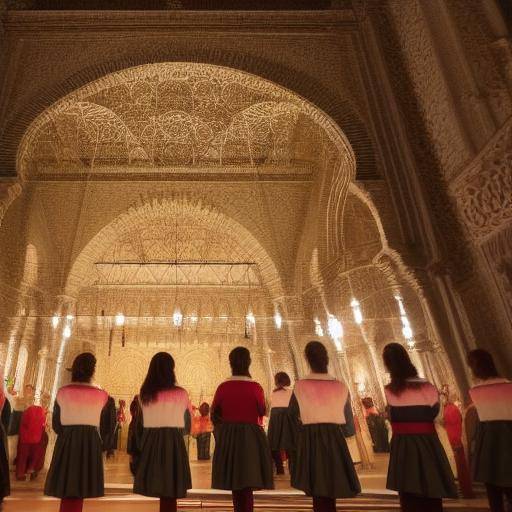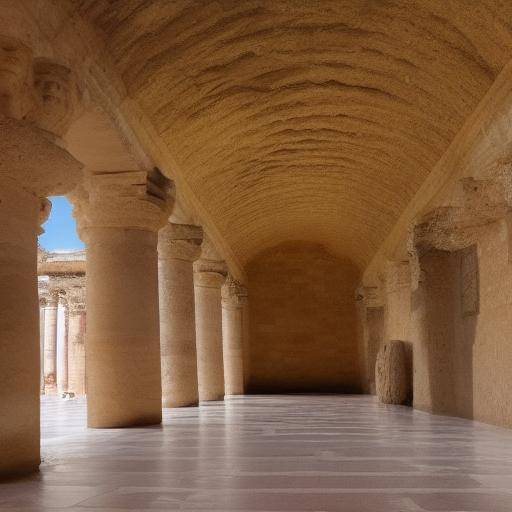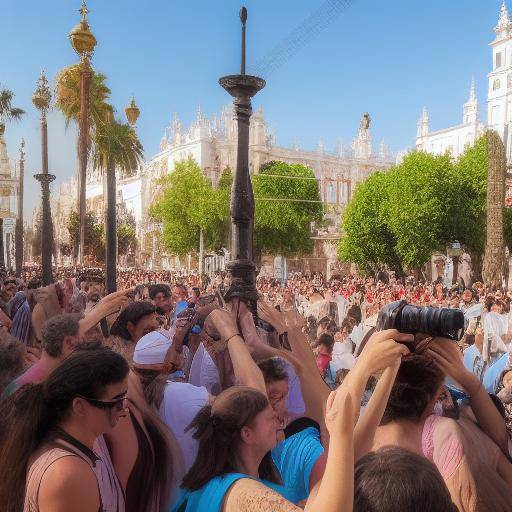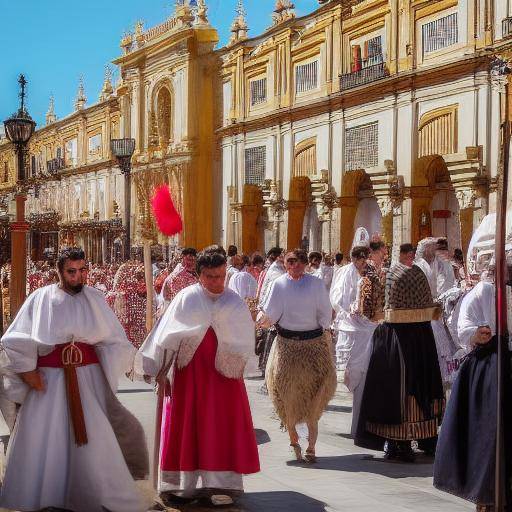
Introduction
Holy Week in Seville is a moment of deep devotion, tradition, and art. Each year, this celebration brings together the sacred and aesthetic in a symphony of imagery, music, and Andalusian sacred art. In this extensive guide, we will explore the richness of this religious festival, the art that surrounds it, and its entrenched Andalusian creativity. From its origins to current trends, we will immerse ourselves in a world of unique artistic expression, deep religiosity, and rooted traditions.
This guide aims to provide a complete and enriching vision of the Holy Week in Seville, the associated religious art and the Andalusian creative contribution in this context. From history and art to future aspects and emerging trends, this article is an invaluable source of information for those seeking to understand and appreciate the cultural and spiritual richness of this unique celebration.
History and Background
The Holy Week in Seville has its roots in the 16th century, when the union brothers began to celebrate religious processions. During the following centuries, these processions became an artistic and devotional expression of great importance to the city. Sacred art, in the form of sculptures and religious images, became a central element of these celebrations, with artists such as Martínez Montañés and Juan de Mesa leaving a lasting legacy in Andalusian religious imagery.
The Holy Week processions also led to the incorporation of sacred music, with the music bands playing a crucial role in the atmosphere and emotional background of the parades. In the area of architecture, churches, chapels and other religious spaces became canvases in which Andalusian architects and artists shaped their creative genius.
The Holy Week in Seville has experienced changes and evolutions over the centuries, but has maintained its deep connection with religious art and Andalusian creativity. Sisters continue to commission new sculptures and religious images, and contemporary musicians and artists explore new forms of artistic expression that continue to enrich this celebration.
Analysis in Deep
The Holy Week in Seville is not only a religious expression, but also a cultural event of great relevance. This celebration attracts visitors from around the world who seek to experience the unique combination of devotion and art that characterizes it. Processions, religious images and sacred music provide a sensory experience that transcends the purely religious and becomes a form of art itself.
Another fundamental aspect is the economic impact of Holy Week in Seville, as it generates an important tourist activity and contributes significantly to the local economy. Sacred art in the form of sculptures, paintings and religious ornaments also constitutes an important pillar of the art industry in the region, generating employment and promoting cultural development.
Comprehensive review
The Holy Week in Seville, religious art and Andalusian creativity have a profound and multifaceted impact on the life of the city and its inhabitants. From a broader perspective, these artistic expressions also play a crucial role in building Andalusian cultural identity. The artistic richness surrounding Holy Week contributes to the international projection of Seville as a centre of artistic and cultural excellence.
Comparative analysis
Holy Week, religious art and Andalusian creativity share an intrinsic link that manifests itself in devotion, aesthetics and tradition. Religious imagery is both a manifestation of faith and an artistic expression, while sacred music provides the emotional soundtrack of the celebration. Andalusian creativity permeates every aspect of Holy Week, from the preparation of the processional steps to the ornamentation of churches and chapels.
Practical Tips and Accessible Advice
If you want to experience Easter in Seville in a deeper way, here are some practical tips:
- Plan your visit: Holy Week attracts a large influx of visitors, so it is important to plan in advance. Check the procession schedule and choose those you would like to witness.
- Enjoy local cuisine: Take the opportunity to taste the delicious Andalusian cuisine, which includes dishes such as fried fish, tapas and gazpacho.
- It respects traditions: During Holy Week, it is essential to show respect for the devotional and artistic expressions you will witness. Be sure to follow the directions of the Sisters and respect the sacred spaces.
Industrial Looks and Expert Reviews
Artists, musicians and artisans participating in Holy Week in Seville represent a wide spectrum of talent and creativity. During this celebration, the synergy between religious tradition and Andalusian artistic ingenuity is manifested in an extraordinary way. It is important to highlight the role of these creators in the preservation and evolution of sacred art, as well as their contribution to the cultural and tourist attraction of the city.
Case Studies and Real Life Applications
A notable example of the intersection between Holy Week, religious art and Andalusian creativity is the work of contemporary imagers, who continue the tradition of sculpting religious images with an innovative approach. Their creations have been instrumental in keeping the artistic tradition alive, while exploring new techniques and stylistic approaches.
Future Trends and Predictions
In the context of the Holy Week in Seville, a continuous growth is expected in the valuation and promotion of sacred art as an integral part of the cultural and tourist experience of the city. In addition, artistic manifestations will continue to evolve in response to social and cultural changes, thus maintaining their relevance in the twenty-first century.
Conclusion
Holy Week in Seville is a tribute to devotion, creativity, and Andalusian sacral art, which intertwine uniquely to give life to an incomparable celebration. As we have explored its history, its current impact and its future potential, we immerse ourselves in a world of profound spiritual and aesthetic significance. This guide seeks to provide a complete and enriching understanding of this unique celebration, as well as its link to religious art and Andalusian creativity.
We hope that this dive in the Holy Week in Seville and its rich artistic and cultural context has been a revealing experience. If you want to delve into some of the aspects we have addressed, we encourage you to explore our specialized sections.
FAQs
What is the importance of Holy Week in Seville?
Holy Week in Seville is of vital importance both in the religious and cultural spheres. In addition to being a manifestation of faith, it is also an event of great cultural and tourist relevance to the city.
What is the role of religious art in Holy Week?
Religious art plays a central role in Holy Week, as religious sculptures, images and ornaments contribute to the artistic expression and atmosphere of this celebration.
How does Andalusian creativity manifest during Holy Week?
Andalusian creativity is manifested through religious imagery, sacred music, the ornamentation of the processional steps, and the preservation of artistic traditions rooted in the region.
What is the difference between Easter in Seville and other regions of Spain?
Each region of Spain has its own distinctive traditions and features in the celebration of Holy Week. The Holy Week in Seville is distinguished by its rich religious imagery, the active participation of the sisterhoods and brotherhoods, and the presence of specific musical and artistic styles of the region.
How is the creative process carried out in the elaboration of religious images?
The creative process in the elaboration of religious images implies careful planning, carved of wood in the case of sculptures, and a deep understanding of religious iconography and traditional aesthetics.
What is the economic contribution of Holy Week in Seville?
The Holy Week in Seville represents an important economic contribution through tourism, the promotion of crafts and sacred art, and the generation of temporary employment in sectors related to the celebration.
We hope that these answers have clarified your doubts about Holy Week in Seville, religious art and Andalusian creativity!
With its deep historical roots, its influence on contemporary life and its projection towards the future, the Holy Week in Seville continues to captivate devotees, artists, and visitors alike. This unique celebration, intrinsically intertwined with religious art and Andalusian creativity, treasures a deep cultural legacy and a lasting attraction that transcends temporal and spatial boundaries.
The richness of Holy Week in Seville and its sacred art is a testimony of the power of artistic expression to connect the divine with the human, giving shape to a legacy that endures over the centuries.




